Galois Theory and Field Extensions
VerifiedAdded on 2023/01/13
|5
|1521
|49
AI Summary
This document discusses Galois Theory and its applications in field extensions. It covers topics such as irreducible polynomials, primitive roots of unity, the Galois group, and the construction of Lagrange resolvent. The document also explores the relationship between different fields and their subfields. It provides a comprehensive understanding of Galois Theory and its significance in mathematics.
Contribute Materials
Your contribution can guide someone’s learning journey. Share your
documents today.
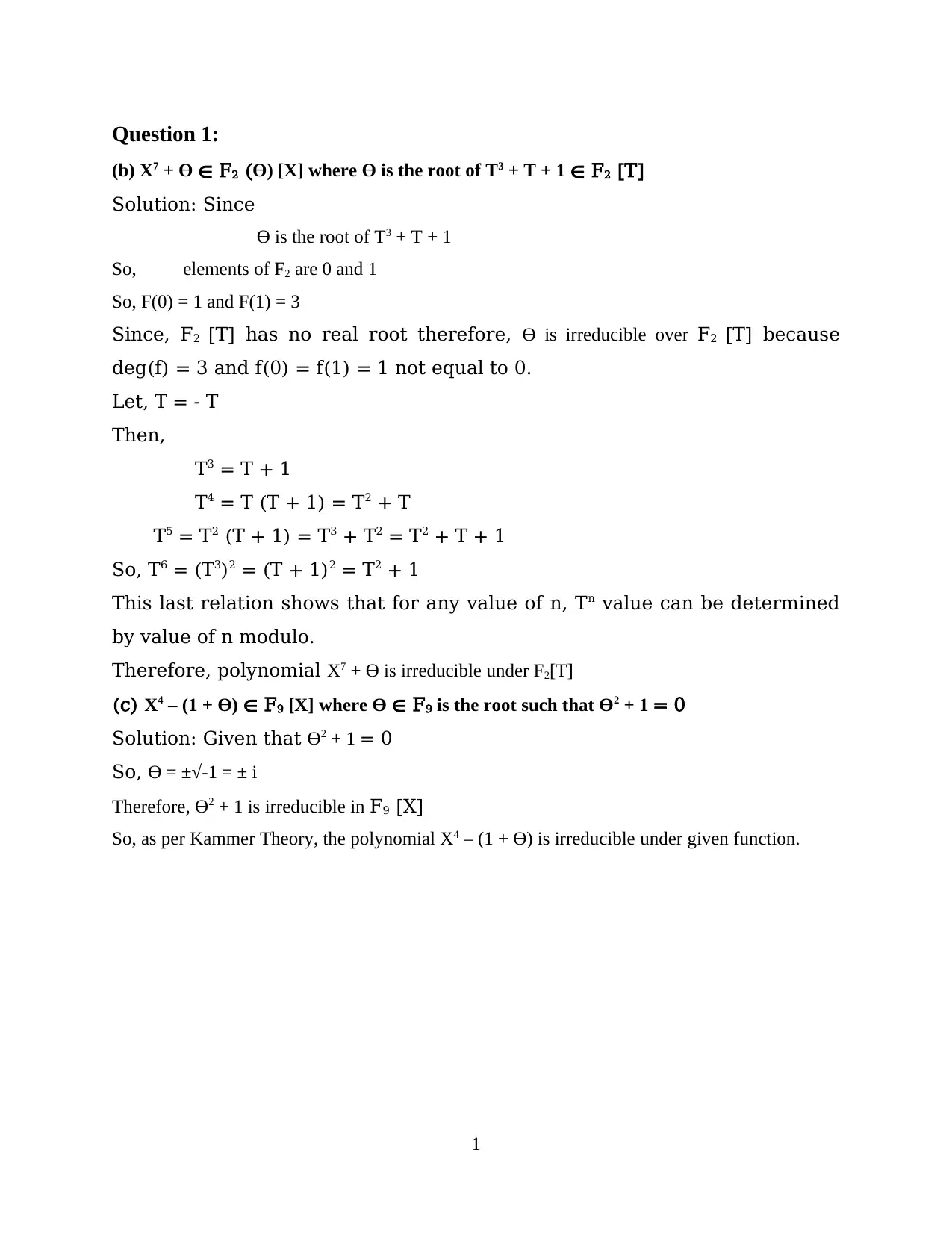
Question 1:
(b) X7 + Ө ∈ F2 (Ө) [X] where Ө is the root of T3 + T + 1 ∈ F2 [T]
Solution: Since
Ө is the root of T3 + T + 1
So, elements of F2 are 0 and 1
So, F(0) = 1 and F(1) = 3
Since, F2 [T] has no real root therefore, Ө is irreducible over F2 [T] because
deg(f) = 3 and f(0) = f(1) = 1 not equal to 0.
Let, T = - T
Then,
T3 = T + 1
T4 = T (T + 1) = T2 + T
T5 = T2 (T + 1) = T3 + T2 = T2 + T + 1
So, T6 = (T3)2 = (T + 1)2 = T2 + 1
This last relation shows that for any value of n, Tn value can be determined
by value of n modulo.
Therefore, polynomial X7 + Ө is irreducible under F2[T]
(c) X4 – (1 + Ө) ∈ F9 [X] where Ө ∈ F9 is the root such that Ө2 + 1 = 0
Solution: Given that Ө2 + 1 = 0
So, Ө = ±√-1 = ± i
Therefore, Ө2 + 1 is irreducible in F9 [X]
So, as per Kammer Theory, the polynomial X4 – (1 + Ө) is irreducible under given function.
1
(b) X7 + Ө ∈ F2 (Ө) [X] where Ө is the root of T3 + T + 1 ∈ F2 [T]
Solution: Since
Ө is the root of T3 + T + 1
So, elements of F2 are 0 and 1
So, F(0) = 1 and F(1) = 3
Since, F2 [T] has no real root therefore, Ө is irreducible over F2 [T] because
deg(f) = 3 and f(0) = f(1) = 1 not equal to 0.
Let, T = - T
Then,
T3 = T + 1
T4 = T (T + 1) = T2 + T
T5 = T2 (T + 1) = T3 + T2 = T2 + T + 1
So, T6 = (T3)2 = (T + 1)2 = T2 + 1
This last relation shows that for any value of n, Tn value can be determined
by value of n modulo.
Therefore, polynomial X7 + Ө is irreducible under F2[T]
(c) X4 – (1 + Ө) ∈ F9 [X] where Ө ∈ F9 is the root such that Ө2 + 1 = 0
Solution: Given that Ө2 + 1 = 0
So, Ө = ±√-1 = ± i
Therefore, Ө2 + 1 is irreducible in F9 [X]
So, as per Kammer Theory, the polynomial X4 – (1 + Ө) is irreducible under given function.
1
Secure Best Marks with AI Grader
Need help grading? Try our AI Grader for instant feedback on your assignments.
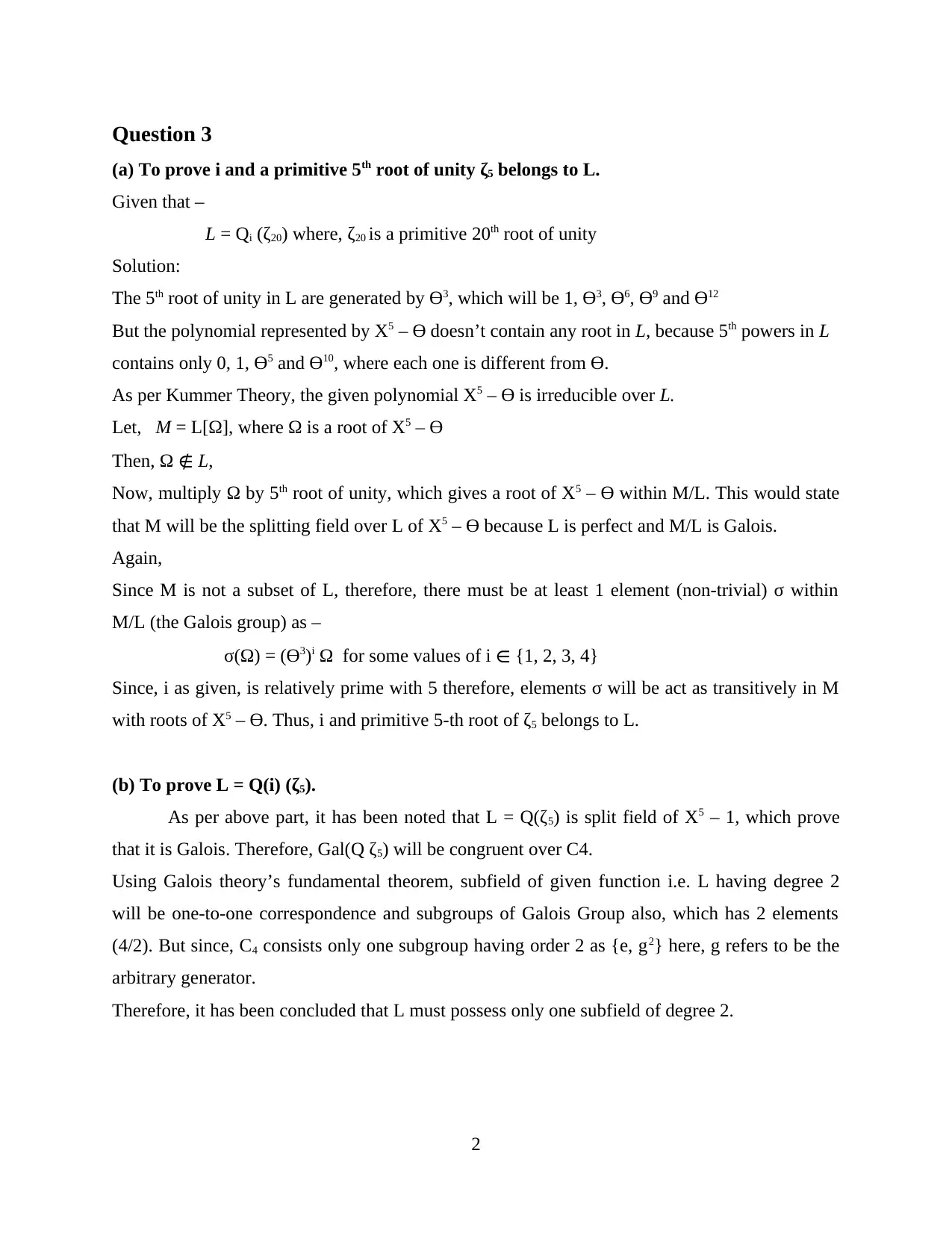
Question 3
(a) To prove i and a primitive 5th root of unity ζ5 belongs to L.
Given that –
L = Qi (ζ20) where, ζ20 is a primitive 20th root of unity
Solution:
The 5th root of unity in L are generated by Ө3, which will be 1, Ө3, Ө6, Ө9 and Ө12
But the polynomial represented by X5 – Ө doesn’t contain any root in L, because 5th powers in L
contains only 0, 1, Ө5 and Ө10, where each one is different from Ө.
As per Kummer Theory, the given polynomial X5 – Ө is irreducible over L.
Let, M = L[Ω], where Ω is a root of X5 – Ө
Then, Ω ∉ L,
Now, multiply Ω by 5th root of unity, which gives a root of X5 – Ө within M/L. This would state
that M will be the splitting field over L of X5 – Ө because L is perfect and M/L is Galois.
Again,
Since M is not a subset of L, therefore, there must be at least 1 element (non-trivial) σ within
M/L (the Galois group) as –
σ(Ω) = (Ө3)i Ω for some values of i ∈ {1, 2, 3, 4}
Since, i as given, is relatively prime with 5 therefore, elements σ will be act as transitively in M
with roots of X5 – Ө. Thus, i and primitive 5-th root of ζ5 belongs to L.
(b) To prove L = Q(i) (ζ5).
As per above part, it has been noted that L = Q(ζ5) is split field of X5 – 1, which prove
that it is Galois. Therefore, Gal(Q ζ5) will be congruent over C4.
Using Galois theory’s fundamental theorem, subfield of given function i.e. L having degree 2
will be one-to-one correspondence and subgroups of Galois Group also, which has 2 elements
(4/2). But since, C4 consists only one subgroup having order 2 as {e, g2} here, g refers to be the
arbitrary generator.
Therefore, it has been concluded that L must possess only one subfield of degree 2.
2
(a) To prove i and a primitive 5th root of unity ζ5 belongs to L.
Given that –
L = Qi (ζ20) where, ζ20 is a primitive 20th root of unity
Solution:
The 5th root of unity in L are generated by Ө3, which will be 1, Ө3, Ө6, Ө9 and Ө12
But the polynomial represented by X5 – Ө doesn’t contain any root in L, because 5th powers in L
contains only 0, 1, Ө5 and Ө10, where each one is different from Ө.
As per Kummer Theory, the given polynomial X5 – Ө is irreducible over L.
Let, M = L[Ω], where Ω is a root of X5 – Ө
Then, Ω ∉ L,
Now, multiply Ω by 5th root of unity, which gives a root of X5 – Ө within M/L. This would state
that M will be the splitting field over L of X5 – Ө because L is perfect and M/L is Galois.
Again,
Since M is not a subset of L, therefore, there must be at least 1 element (non-trivial) σ within
M/L (the Galois group) as –
σ(Ω) = (Ө3)i Ω for some values of i ∈ {1, 2, 3, 4}
Since, i as given, is relatively prime with 5 therefore, elements σ will be act as transitively in M
with roots of X5 – Ө. Thus, i and primitive 5-th root of ζ5 belongs to L.
(b) To prove L = Q(i) (ζ5).
As per above part, it has been noted that L = Q(ζ5) is split field of X5 – 1, which prove
that it is Galois. Therefore, Gal(Q ζ5) will be congruent over C4.
Using Galois theory’s fundamental theorem, subfield of given function i.e. L having degree 2
will be one-to-one correspondence and subgroups of Galois Group also, which has 2 elements
(4/2). But since, C4 consists only one subgroup having order 2 as {e, g2} here, g refers to be the
arbitrary generator.
Therefore, it has been concluded that L must possess only one subfield of degree 2.
2
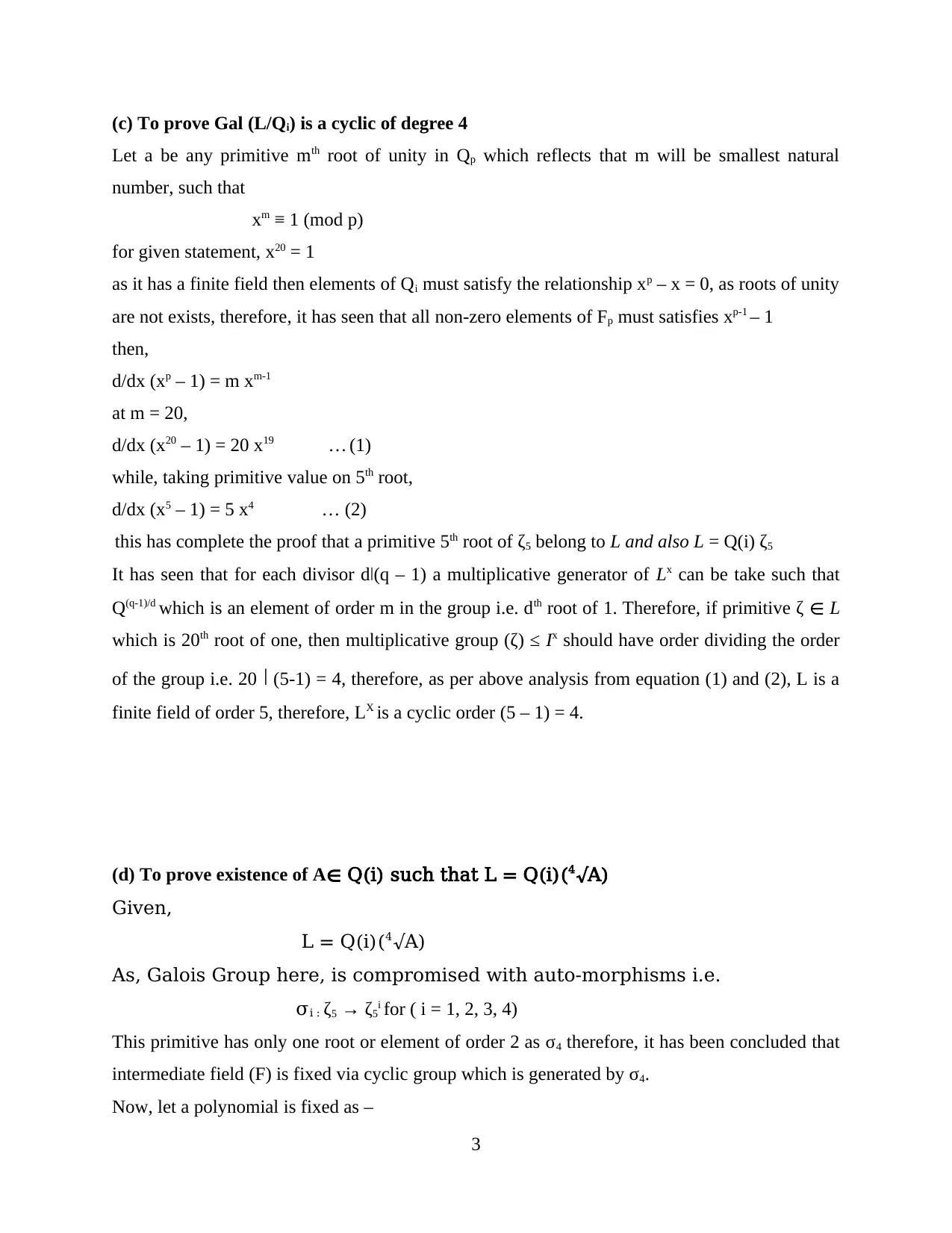
(c) To prove Gal (L/Qi) is a cyclic of degree 4
Let a be any primitive mth root of unity in Qp which reflects that m will be smallest natural
number, such that
xm ≡ 1 (mod p)
for given statement, x20 = 1
as it has a finite field then elements of Qi must satisfy the relationship xp – x = 0, as roots of unity
are not exists, therefore, it has seen that all non-zero elements of Fp must satisfies xp-1 – 1
then,
d/dx (xp – 1) = m xm-1
at m = 20,
d/dx (x20 – 1) = 20 x19 … (1)
while, taking primitive value on 5th root,
d/dx (x5 – 1) = 5 x4 … (2)
this has complete the proof that a primitive 5th root of ζ5 belong to L and also L = Q(i) ζ5
It has seen that for each divisor dǀ(q – 1) a multiplicative generator of Lx can be take such that
Q(q-1)/d which is an element of order m in the group i.e. dth root of 1. Therefore, if primitive ζ ∈ L
which is 20th root of one, then multiplicative group (ζ) ≤ Ix should have order dividing the order
of the group i.e. 20 ǀ (5-1) = 4, therefore, as per above analysis from equation (1) and (2), L is a
finite field of order 5, therefore, LX is a cyclic order (5 – 1) = 4.
(d) To prove existence of A∈ Q(i) such that L = Q(i)(4√A)
Given,
L = Q(i)(4√A)
As, Galois Group here, is compromised with auto-morphisms i.e.
σi : ζ5 → ζ5i for ( i = 1, 2, 3, 4)
This primitive has only one root or element of order 2 as σ4 therefore, it has been concluded that
intermediate field (F) is fixed via cyclic group which is generated by σ4.
Now, let a polynomial is fixed as –
3
Let a be any primitive mth root of unity in Qp which reflects that m will be smallest natural
number, such that
xm ≡ 1 (mod p)
for given statement, x20 = 1
as it has a finite field then elements of Qi must satisfy the relationship xp – x = 0, as roots of unity
are not exists, therefore, it has seen that all non-zero elements of Fp must satisfies xp-1 – 1
then,
d/dx (xp – 1) = m xm-1
at m = 20,
d/dx (x20 – 1) = 20 x19 … (1)
while, taking primitive value on 5th root,
d/dx (x5 – 1) = 5 x4 … (2)
this has complete the proof that a primitive 5th root of ζ5 belong to L and also L = Q(i) ζ5
It has seen that for each divisor dǀ(q – 1) a multiplicative generator of Lx can be take such that
Q(q-1)/d which is an element of order m in the group i.e. dth root of 1. Therefore, if primitive ζ ∈ L
which is 20th root of one, then multiplicative group (ζ) ≤ Ix should have order dividing the order
of the group i.e. 20 ǀ (5-1) = 4, therefore, as per above analysis from equation (1) and (2), L is a
finite field of order 5, therefore, LX is a cyclic order (5 – 1) = 4.
(d) To prove existence of A∈ Q(i) such that L = Q(i)(4√A)
Given,
L = Q(i)(4√A)
As, Galois Group here, is compromised with auto-morphisms i.e.
σi : ζ5 → ζ5i for ( i = 1, 2, 3, 4)
This primitive has only one root or element of order 2 as σ4 therefore, it has been concluded that
intermediate field (F) is fixed via cyclic group which is generated by σ4.
Now, let a polynomial is fixed as –
3
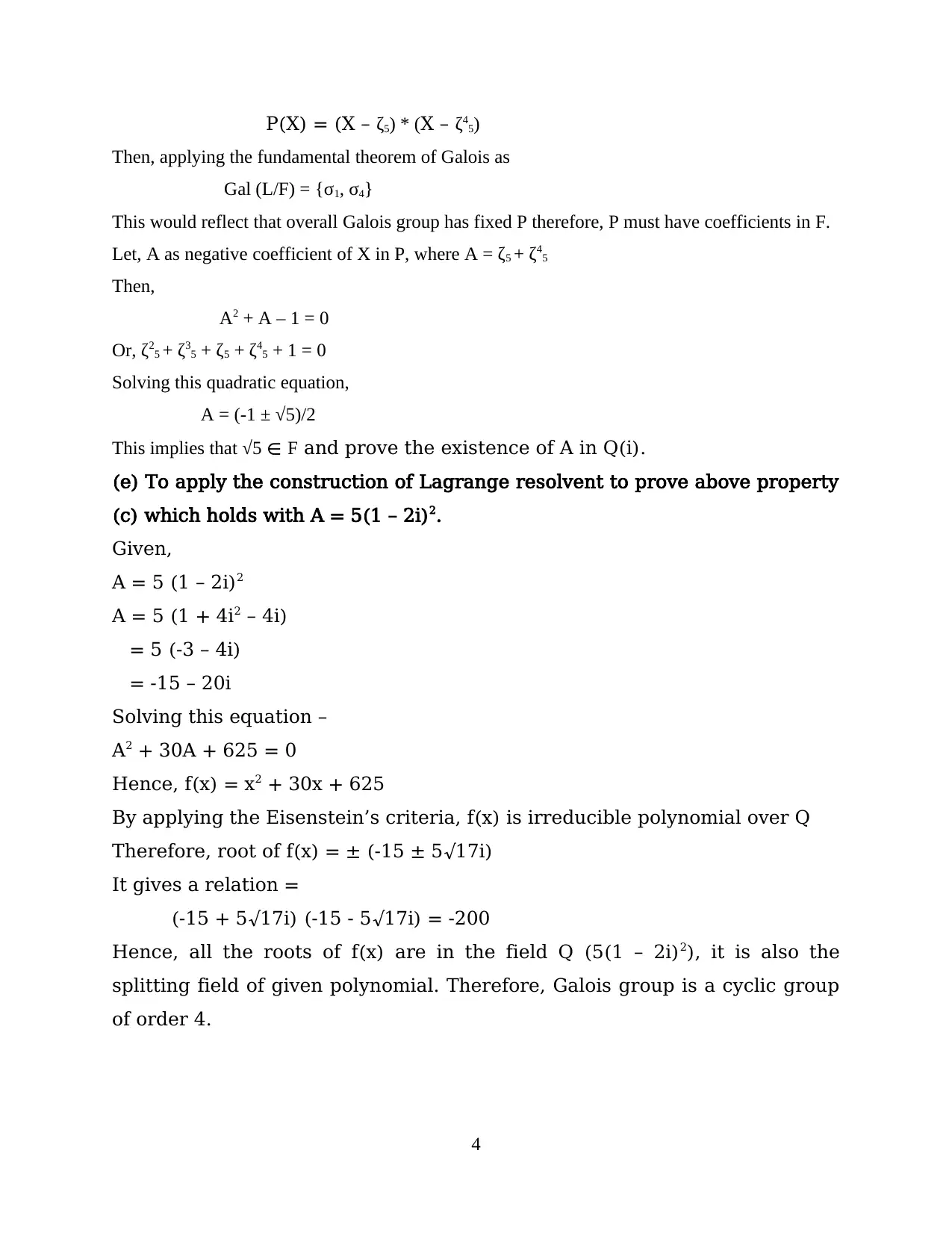
P(X) = (X – ζ5) * (X – ζ45)
Then, applying the fundamental theorem of Galois as
Gal (L/F) = {σ1, σ4}
This would reflect that overall Galois group has fixed P therefore, P must have coefficients in F.
Let, A as negative coefficient of X in P, where A = ζ5 + ζ45
Then,
A2 + A – 1 = 0
Or, ζ25 + ζ35 + ζ5 + ζ45 + 1 = 0
Solving this quadratic equation,
A = (-1 ± √5)/2
This implies that √5 ∈ F and prove the existence of A in Q(i).
(e) To apply the construction of Lagrange resolvent to prove above property
(c) which holds with A = 5(1 – 2i)2.
Given,
A = 5 (1 – 2i)2
A = 5 (1 + 4i2 – 4i)
= 5 (-3 – 4i)
= -15 – 20i
Solving this equation –
A2 + 30A + 625 = 0
Hence, f(x) = x2 + 30x + 625
By applying the Eisenstein’s criteria, f(x) is irreducible polynomial over Q
Therefore, root of f(x) = ± (-15 ± 5√17i)
It gives a relation =
(-15 + 5√17i) (-15 - 5√17i) = -200
Hence, all the roots of f(x) are in the field Q (5(1 – 2i)2), it is also the
splitting field of given polynomial. Therefore, Galois group is a cyclic group
of order 4.
4
Then, applying the fundamental theorem of Galois as
Gal (L/F) = {σ1, σ4}
This would reflect that overall Galois group has fixed P therefore, P must have coefficients in F.
Let, A as negative coefficient of X in P, where A = ζ5 + ζ45
Then,
A2 + A – 1 = 0
Or, ζ25 + ζ35 + ζ5 + ζ45 + 1 = 0
Solving this quadratic equation,
A = (-1 ± √5)/2
This implies that √5 ∈ F and prove the existence of A in Q(i).
(e) To apply the construction of Lagrange resolvent to prove above property
(c) which holds with A = 5(1 – 2i)2.
Given,
A = 5 (1 – 2i)2
A = 5 (1 + 4i2 – 4i)
= 5 (-3 – 4i)
= -15 – 20i
Solving this equation –
A2 + 30A + 625 = 0
Hence, f(x) = x2 + 30x + 625
By applying the Eisenstein’s criteria, f(x) is irreducible polynomial over Q
Therefore, root of f(x) = ± (-15 ± 5√17i)
It gives a relation =
(-15 + 5√17i) (-15 - 5√17i) = -200
Hence, all the roots of f(x) are in the field Q (5(1 – 2i)2), it is also the
splitting field of given polynomial. Therefore, Galois group is a cyclic group
of order 4.
4
Secure Best Marks with AI Grader
Need help grading? Try our AI Grader for instant feedback on your assignments.
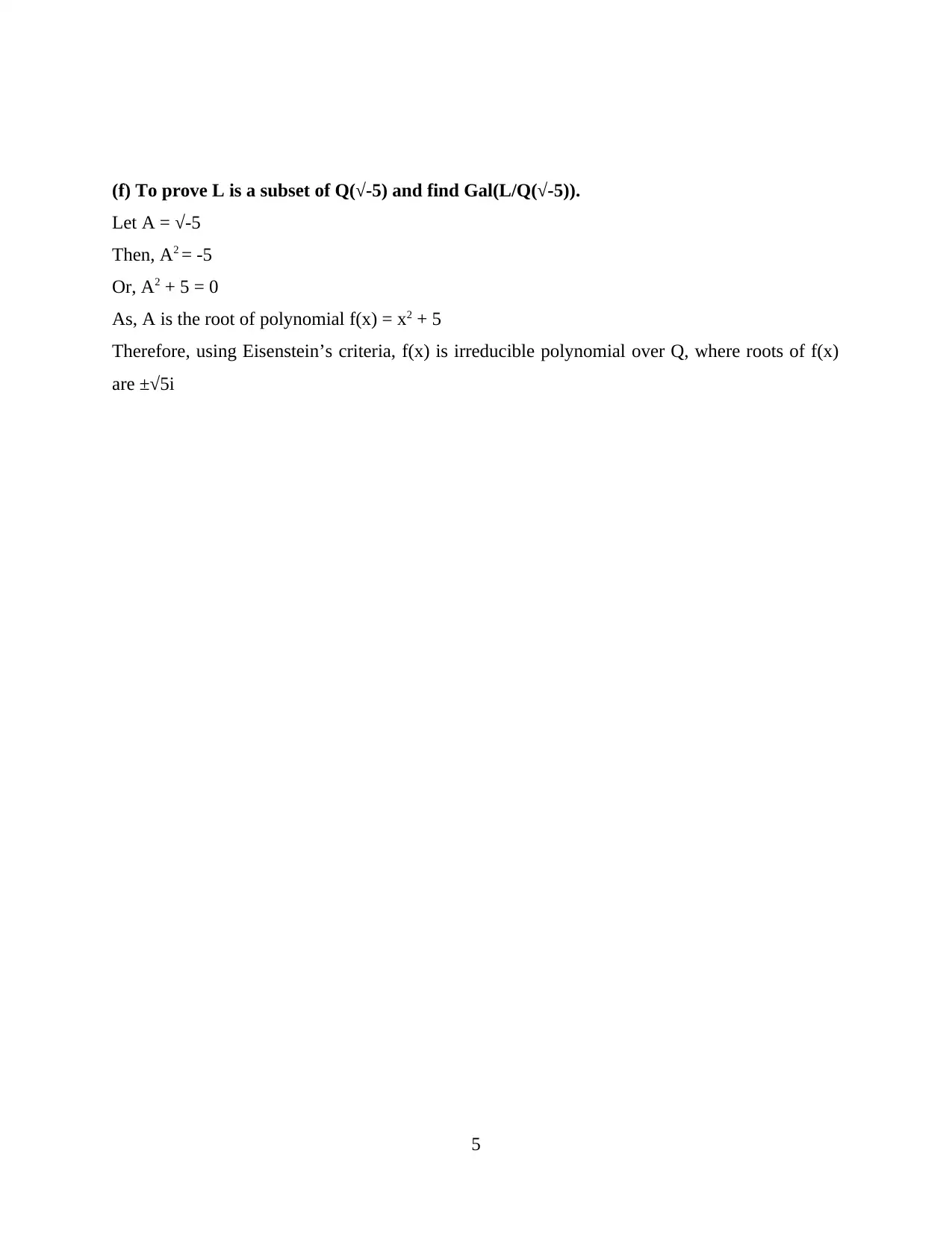
(f) To prove L is a subset of Q(√-5) and find Gal(L/Q(√-5)).
Let A = √-5
Then, A2 = -5
Or, A2 + 5 = 0
As, A is the root of polynomial f(x) = x2 + 5
Therefore, using Eisenstein’s criteria, f(x) is irreducible polynomial over Q, where roots of f(x)
are ±√5i
5
Let A = √-5
Then, A2 = -5
Or, A2 + 5 = 0
As, A is the root of polynomial f(x) = x2 + 5
Therefore, using Eisenstein’s criteria, f(x) is irreducible polynomial over Q, where roots of f(x)
are ±√5i
5
1 out of 5
Related Documents
Your All-in-One AI-Powered Toolkit for Academic Success.
+13062052269
info@desklib.com
Available 24*7 on WhatsApp / Email
![[object Object]](/_next/static/media/star-bottom.7253800d.svg)
Unlock your academic potential
© 2024 | Zucol Services PVT LTD | All rights reserved.
